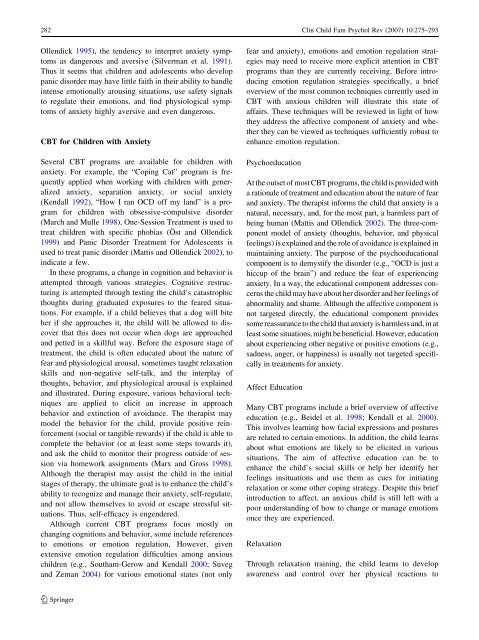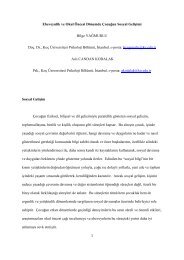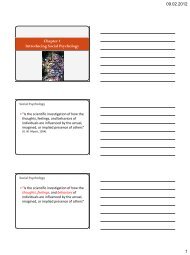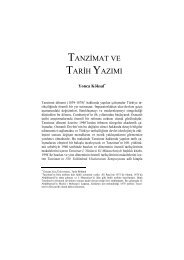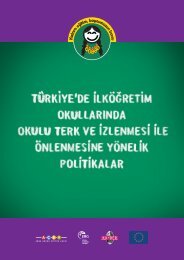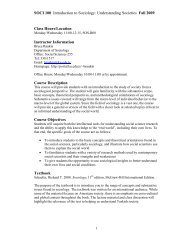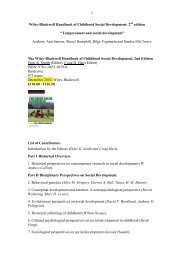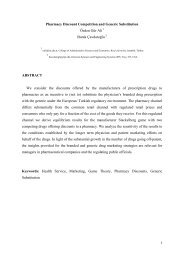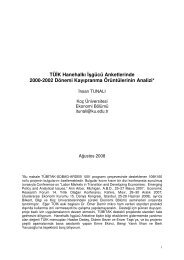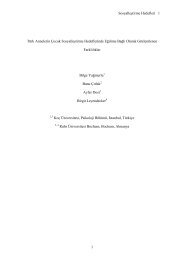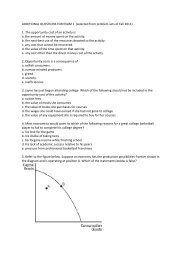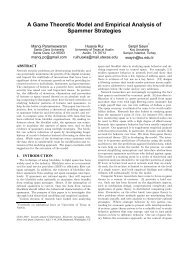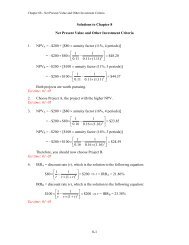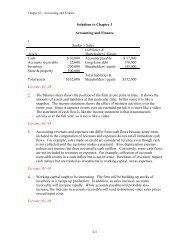The Role of Emotion Regulation in the Treatment of Child Anxiety ...
The Role of Emotion Regulation in the Treatment of Child Anxiety ...
The Role of Emotion Regulation in the Treatment of Child Anxiety ...
Create successful ePaper yourself
Turn your PDF publications into a flip-book with our unique Google optimized e-Paper software.
282 Cl<strong>in</strong> <strong>Child</strong> Fam Psychol Rev (2007) 10:275–293<br />
Ollendick 1995), <strong>the</strong> tendency to <strong>in</strong>terpret anxiety symptoms<br />
as dangerous and aversive (Silverman et al. 1991).<br />
Thus it seems that children and adolescents who develop<br />
panic disorder may have little faith <strong>in</strong> <strong>the</strong>ir ability to handle<br />
<strong>in</strong>tense emotionally arous<strong>in</strong>g situations, use safety signals<br />
to regulate <strong>the</strong>ir emotions, and f<strong>in</strong>d physiological symptoms<br />
<strong>of</strong> anxiety highly aversive and even dangerous.<br />
CBT for <strong>Child</strong>ren with <strong>Anxiety</strong><br />
Several CBT programs are available for children with<br />
anxiety. For example, <strong>the</strong> “Cop<strong>in</strong>g Cat” program is frequently<br />
applied when work<strong>in</strong>g with children with generalized<br />
anxiety, separation anxiety, or social anxiety<br />
(Kendall 1992), “How I ran OCD <strong>of</strong>f my land” is a program<br />
for children with obsessive-compulsive disorder<br />
(March and Mulle 1998), One-Session <strong>Treatment</strong> is used to<br />
treat children with specific phobias (Öst and Ollendick<br />
1999) and Panic Disorder <strong>Treatment</strong> for Adolescents is<br />
used to treat panic disorder (Mattis and Ollendick 2002), to<br />
<strong>in</strong>dicate a few.<br />
In <strong>the</strong>se programs, a change <strong>in</strong> cognition and behavior is<br />
attempted through various strategies. Cognitive restructur<strong>in</strong>g<br />
is attempted through test<strong>in</strong>g <strong>the</strong> child’s catastrophic<br />
thoughts dur<strong>in</strong>g graduated exposures to <strong>the</strong> feared situations.<br />
For example, if a child believes that a dog will bite<br />
her if she approaches it, <strong>the</strong> child will be allowed to discover<br />
that this does not occur when dogs are approached<br />
and petted <strong>in</strong> a skillful way. Before <strong>the</strong> exposure stage <strong>of</strong><br />
treatment, <strong>the</strong> child is <strong>of</strong>ten educated about <strong>the</strong> nature <strong>of</strong><br />
fear and physiological arousal, sometimes taught relaxation<br />
skills and non-negative self-talk, and <strong>the</strong> <strong>in</strong>terplay <strong>of</strong><br />
thoughts, behavior, and physiological arousal is expla<strong>in</strong>ed<br />
and illustrated. Dur<strong>in</strong>g exposure, various behavioral techniques<br />
are applied to elicit an <strong>in</strong>crease <strong>in</strong> approach<br />
behavior and ext<strong>in</strong>ction <strong>of</strong> avoidance. <strong>The</strong> <strong>the</strong>rapist may<br />
model <strong>the</strong> behavior for <strong>the</strong> child, provide positive re<strong>in</strong>forcement<br />
(social or tangible rewards) if <strong>the</strong> child is able to<br />
complete <strong>the</strong> behavior (or at least some steps towards it),<br />
and ask <strong>the</strong> child to monitor <strong>the</strong>ir progress outside <strong>of</strong> session<br />
via homework assignments (Marx and Gross 1998).<br />
Although <strong>the</strong> <strong>the</strong>rapist may assist <strong>the</strong> child <strong>in</strong> <strong>the</strong> <strong>in</strong>itial<br />
stages <strong>of</strong> <strong>the</strong>rapy, <strong>the</strong> ultimate goal is to enhance <strong>the</strong> child’s<br />
ability to recognize and manage <strong>the</strong>ir anxiety, self-regulate,<br />
and not allow <strong>the</strong>mselves to avoid or escape stressful situations.<br />
Thus, self-efficacy is engendered.<br />
Although current CBT programs focus mostly on<br />
chang<strong>in</strong>g cognitions and behavior, some <strong>in</strong>clude references<br />
to emotions or emotion regulation, However, given<br />
extensive emotion regulation difficulties among anxious<br />
children (e.g., Southam-Gerow and Kendall 2000; Suveg<br />
and Zeman 2004) for various emotional states (not only<br />
fear and anxiety), emotions and emotion regulation strategies<br />
may need to receive more explicit attention <strong>in</strong> CBT<br />
programs than <strong>the</strong>y are currently receiv<strong>in</strong>g. Before <strong>in</strong>troduc<strong>in</strong>g<br />
emotion regulation strategies specifically, a brief<br />
overview <strong>of</strong> <strong>the</strong> most common techniques currently used <strong>in</strong><br />
CBT with anxious children will illustrate this state <strong>of</strong><br />
affairs. <strong>The</strong>se techniques will be reviewed <strong>in</strong> light <strong>of</strong> how<br />
<strong>the</strong>y address <strong>the</strong> affective component <strong>of</strong> anxiety and whe<strong>the</strong>r<br />
<strong>the</strong>y can be viewed as techniques sufficiently robust to<br />
enhance emotion regulation.<br />
Psychoeducation<br />
At <strong>the</strong> outset <strong>of</strong> most CBT programs, <strong>the</strong> child is provided with<br />
a rationale <strong>of</strong> treatment and education about <strong>the</strong> nature <strong>of</strong> fear<br />
and anxiety. <strong>The</strong> <strong>the</strong>rapist <strong>in</strong>forms <strong>the</strong> child that anxiety is a<br />
natural, necessary, and, for <strong>the</strong> most part, a harmless part <strong>of</strong><br />
be<strong>in</strong>g human (Mattis and Ollendick 2002). <strong>The</strong> three-component<br />
model <strong>of</strong> anxiety (thoughts, behavior, and physical<br />
feel<strong>in</strong>gs) is expla<strong>in</strong>ed and <strong>the</strong> role <strong>of</strong> avoidance is expla<strong>in</strong>ed <strong>in</strong><br />
ma<strong>in</strong>ta<strong>in</strong><strong>in</strong>g anxiety. <strong>The</strong> purpose <strong>of</strong> <strong>the</strong> psychoeducational<br />
component is to demystify <strong>the</strong> disorder (e.g., “OCD is just a<br />
hiccup <strong>of</strong> <strong>the</strong> bra<strong>in</strong>”) and reduce <strong>the</strong> fear <strong>of</strong> experienc<strong>in</strong>g<br />
anxiety. In a way, <strong>the</strong> educational component addresses concerns<br />
<strong>the</strong> child may have about her disorder and her feel<strong>in</strong>gs <strong>of</strong><br />
abnormality and shame. Although <strong>the</strong> affective component is<br />
not targeted directly, <strong>the</strong> educational component provides<br />
some reassurance to <strong>the</strong> child that anxiety is harmless and, <strong>in</strong> at<br />
least some situations, might be beneficial. However, education<br />
about experienc<strong>in</strong>g o<strong>the</strong>r negative or positive emotions (e.g.,<br />
sadness, anger, or happ<strong>in</strong>ess) is usually not targeted specifically<br />
<strong>in</strong> treatments for anxiety.<br />
Affect Education<br />
Many CBT programs <strong>in</strong>clude a brief overview <strong>of</strong> affective<br />
education (e.g., Beidel et al. 1998; Kendall et al. 2000).<br />
This <strong>in</strong>volves learn<strong>in</strong>g how facial expressions and postures<br />
are related to certa<strong>in</strong> emotions. In addition, <strong>the</strong> child learns<br />
about what emotions are likely to be elicited <strong>in</strong> various<br />
situations. <strong>The</strong> aim <strong>of</strong> affective education can be to<br />
enhance <strong>the</strong> child’s social skills or help her identify her<br />
feel<strong>in</strong>gs <strong>in</strong>situations and use <strong>the</strong>m as cues for <strong>in</strong>itiat<strong>in</strong>g<br />
relaxation or some o<strong>the</strong>r cop<strong>in</strong>g strategy. Despite this brief<br />
<strong>in</strong>troduction to affect, an anxious child is still left with a<br />
poor understand<strong>in</strong>g <strong>of</strong> how to change or manage emotions<br />
once <strong>the</strong>y are experienced.<br />
Relaxation<br />
Through relaxation tra<strong>in</strong><strong>in</strong>g, <strong>the</strong> child learns to develop<br />
awareness and control over her physical reactions to<br />
123


